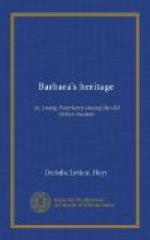“Can you give us any dates of these periods to remember, uncle?” asked Malcom.
“Roughly speaking, the Gothic period covers the years from about 1250 to 1400; the Early Renaissance, from about 1400 to 1500. Masaccio, as we have seen, was the first great painter of the Early Renaissance, and he lived from 1401 to 1428. But these dates are not arbitrary. Fra Angelico lived until 1455, and yet his pictures belong wholly to the Gothic period; so also do those of other Gothic painters whose lives overlap the Early Renaissance in point of time. It is the spirit of the art that definitely determines its place, although the general dates help one to remember.
“We will not talk long of Ghirlandajo,—Domenico Ghirlandajo (for there is another, Ridolfo by name, who is not nearly so important to the art-world). His composition is similar to that of Masaccio. A few people are intimately engaged, and the others are bystanders, or onlookers. One characteristic is that many of these last are portraits of Florentine men and women who were his contemporaries, and so we get from his pictures a knowledge of the people and costumes of his time. His backgrounds are often masses of Florentine architecture, some of which you will readily recognize. His subjects are religious.
“For studying his work, go again to Santa Maria Novella, where is a series of frescoes representing scenes in the lives of the Virgin Mary and John the Baptist. I would give some time to these, for in them you will find all the characteristics of Ghirlandajo’s frescoes, which are his strongest work. Then you will find two good examples of his tempera painting on wooden panels in the Uffizi Gallery: an Adoration of the Magi, and a Madonna and Saints, which are in the Sala di Lorenzo Monaco near Fra Angelico’s Madonna—the one which is surrounded by the famous musical Angels. Others are in the Pitti Gallery and Academy. His goldsmith’s training shows in these smaller pictures more than in the frescoes. We see it in his love for painting golden ornaments and decoration of garments.”
“Is his work anything like that of Michael Angelo, Mr. Sumner?” asked Barbara. “He was Angelo’s teacher, was he not?”
“Yes, history tells us that he held that position for three years; but judging from the work of both, I should say that not much was either taught or learned. Ghirlandajo’s work possesses great strength, as does Michael Angelo’s, but on wholly different lines. Ghirlandajo loved to represent grave, dignified figures,—which were portraits,—clad in long gowns, stiff brocades, and flowing mantles; and there are superb accessories in his pictures,—landscapes, architecture, and decorated interiors. On the other hand, Michael Angelo’s figures are most impersonal, and each depends for effect simply on its own magnificence of conception and rendering. The lines of figures are of far more importance than the face, which is the farthest possible removed from the portrait—and for accessories of any kind he cared not at all.”




